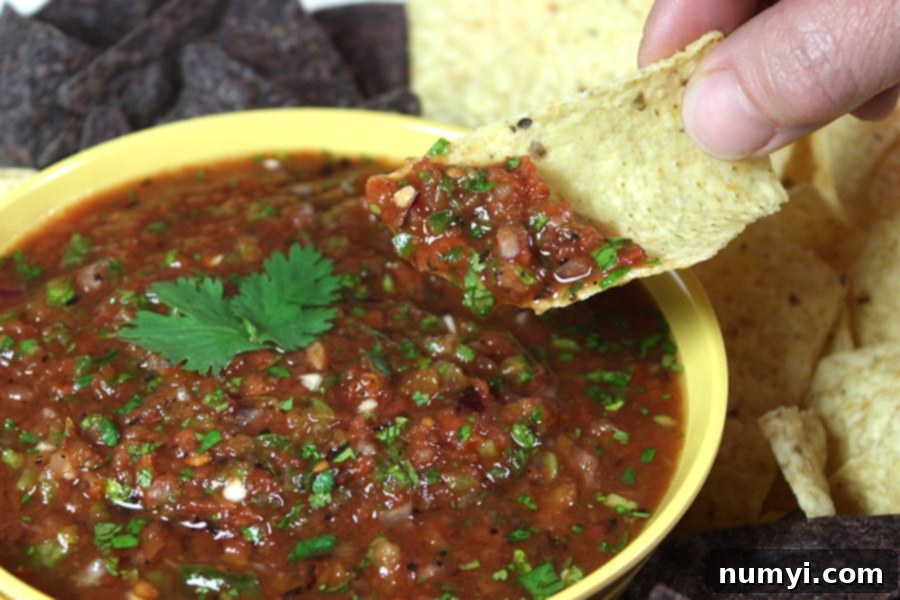Authentic Restaurant-Style Fire Roasted Salsa: Your Ultimate Homemade Dip
Imagine the rich, smoky flavor of your favorite Mexican restaurant’s salsa, but made fresh in your own kitchen in just minutes. Our amazing fire-roasted salsa recipe makes this a reality! With a simple 5-minute prep, a handful of fresh ingredients, and the help of a food processor or blender, you can create a vibrant, flavorful salsa that will elevate any meal or snack.
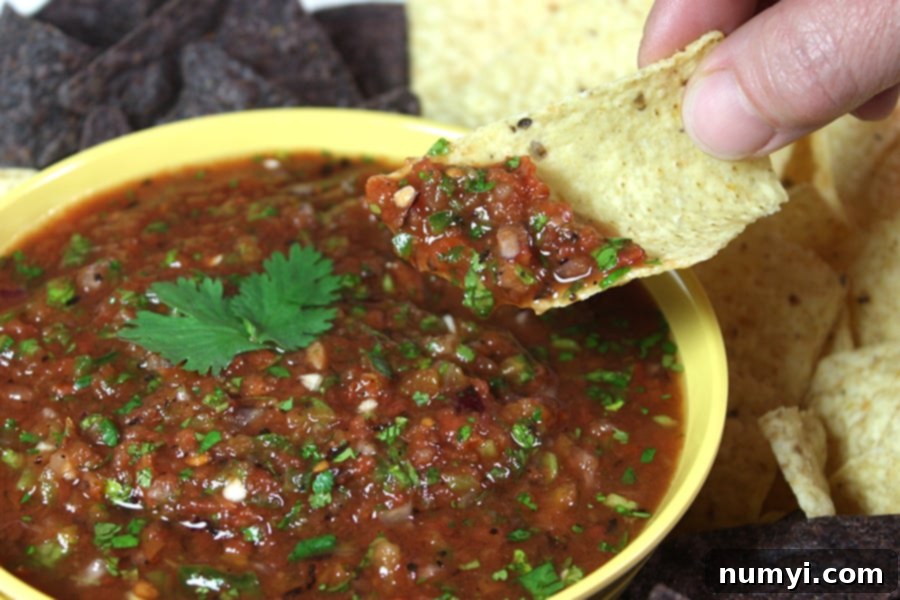
Why You’ll Adore This Easy Fire Roasted Salsa
Once you experience the incredible taste and simplicity of making fire-roasted salsa at home, you’ll wonder why you ever bought a jarred version. My family is absolutely obsessed with this restaurant-style salsa; it disappears so quickly that I can barely keep it stocked! This recipe isn’t just good; it’s a game-changer for anyone who appreciates the authentic flavors of Mexican cuisine.
- Unbeatable Flavor: The star of this recipe, fire-roasted tomatoes, infuses the salsa with a deep, smoky undertone that can’t be achieved with regular canned or fresh tomatoes. This unique flavor profile is what makes it truly taste like it came straight from your favorite taqueria.
- Effortless Preparation: Forget complicated steps or lengthy cooking times. This salsa boasts a minimal 5-minute prep time. Simply chop a few ingredients, toss them into a food processor or blender, and pulse your way to perfection.
- Beyond Store-Bought: Most store-bought salsas lack the vibrant freshness and depth of flavor found in homemade versions. This recipe delivers a salsa that is fresh-tasting, perfectly seasoned, and bursting with natural ingredients, easily surpassing anything you’d find on a grocery shelf.
- Spice Up Your Meals: Elevate your ordinary weeknight dinners! Whether it’s Taco Tuesday or a casual weekend gathering, this homemade salsa adds a fresh and zesty kick. It’s also incredibly versatile.
- Perfect Pairings: We love serving this easy fire roasted salsa as an essential component for a variety of dishes. It’s a fantastic extra sauce for hearty chicken burrito bowls, a zesty topping for loaded sheet pan beef nachos, a fresh accompaniment to crispy baked chicken chimichangas, and a flavorful addition to succulent crispy cubed pork carnitas. Don’t limit it to just Mexican dishes; it’s also amazing with grilled chicken, eggs, or as a vibrant dip for fresh vegetables.
- Customizable Heat: You are in complete control of the spice level, allowing you to tailor it perfectly to your family’s preference.
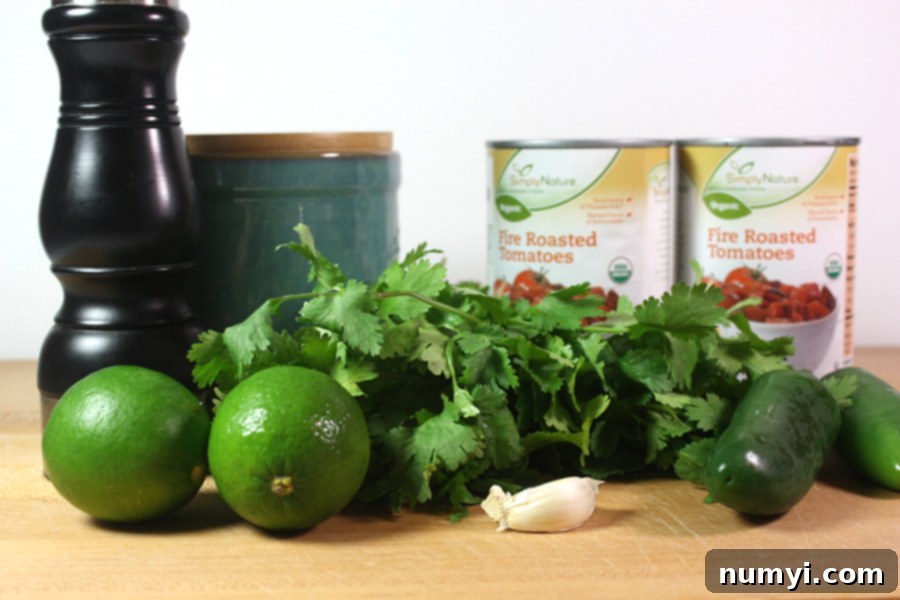
Key Ingredients for Smoky Fire Roasted Salsa
Creating this delicious, restaurant-quality salsa requires just a few simple ingredients. The secret lies in using fire-roasted components to achieve that signature smoky depth.
- Fire Roasted Tomatoes – These are the absolute cornerstone of this recipe. Using fire-roasted tomatoes, typically found in cans, provides a rich, smoky flavor that regular canned or fresh tomatoes simply cannot replicate. I usually opt for diced fire-roasted tomatoes for convenience, but whole fire-roasted tomatoes can also be used and will break down perfectly in the processor.
- Garlic – Fresh garlic is crucial for a bright, pungent flavor. This recipe calls for 2 teaspoons of fresh minced garlic, which usually translates to 2-3 cloves depending on their size. Feel free to adjust this amount to your personal taste – garlic lovers might add a little more! I find a garlic press makes mincing quick and easy, but a rough chop before blending works just as well.
- Red Onion – Red onion adds a beautiful color and a slightly milder, sweeter flavor compared to white onions. Dicing the onion helps it blend smoothly, but a rough chop is sufficient as your food processor will do most of the work. If red onions aren’t available, yellow or white onions can be substituted, though they might offer a sharper taste. Green onions, while not traditional, can also be used for a milder onion flavor.
- Lime Juice – Freshly squeezed lime juice is a non-negotiable for vibrant, authentic salsa. Its bright acidity cuts through the richness of the tomatoes and balances all the flavors. While bottled lime juice can be used in a pinch, fresh lime juice provides a significantly superior taste and aroma.
- Jalapeños – For the best flavor and texture, always use fresh jalapeños over jarred ones. Jarred jalapeños are pickled and soft, which won’t give you the crisp, fresh heat you’re looking for. For a mild salsa, make sure to remove the seeds and the white membranes (veins) inside the pepper, as this is where most of the heat resides. If you prefer a spicier kick, leave some or all of the seeds and veins intact. For an even bolder heat, consider adding a serrano pepper or two alongside the jalapeños.
- Green Chilies – Canned green chilies (like Anaheim or Hatch chilies) add another layer of mild, earthy pepper flavor without adding too much heat. We typically use mild diced green chilies, but if you enjoy extra spice, opt for hot green chilies.
- Cilantro – Fresh cilantro provides that quintessential bright, herbaceous, and slightly citrusy flavor that is synonymous with Mexican salsa. We use one full bunch of fresh cilantro for a robust flavor. However, I know some people have a genetic predisposition that makes cilantro taste like soap. If you’re one of them, feel free to reduce the amount, omit it entirely, or substitute with a small amount of fresh parsley.
- Seasonings – Simple seasonings are all that’s needed: Kosher salt and freshly ground black pepper. Adjust these to taste after blending your salsa. Kosher salt provides a cleaner taste compared to table salt, and fresh ground pepper always adds more aroma.
It literally takes no time at all to make this incredible salsa. The inherent smoky flavor from the fire-roasted tomatoes perfectly complements the fresh taste of the other ingredients, creating a harmonious and addictive dip. This fire roasted salsa truly beats any store-bought alternative and most Mexican restaurant salsas on any given day!
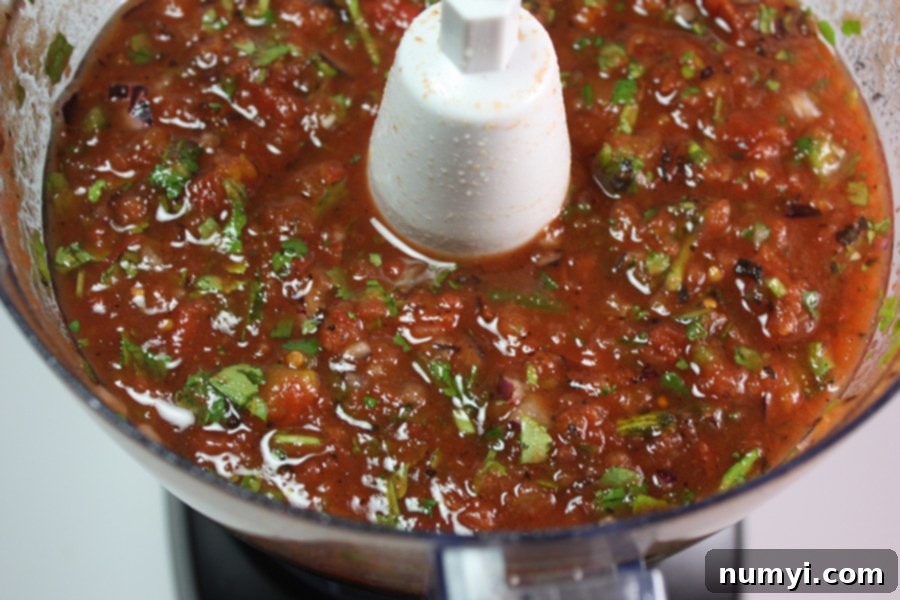
Canned Fire Roasted Tomatoes vs. Fresh Tomatoes
When it comes to salsa, the choice between canned and fresh tomatoes significantly impacts the flavor and consistency. While fresh tomatoes offer undeniable vibrancy, canned fire-roasted tomatoes are a game-changer for this specific recipe, offering ease and a distinct flavor profile.
I genuinely prefer the simplicity and concentrated smoky flavor of using canned fire-roasted tomatoes. Fresh tomatoes, especially many common varieties, can be very watery. This high moisture content often results in a thin, runny salsa, which isn’t ideal. To counteract this when using fresh tomatoes, you would typically need to roast them yourself to cook out some of that moisture and concentrate their flavor.
If You Opt for Fresh Tomatoes:
If you’re determined to use fresh tomatoes for a homemade fire-roasted salsa, I highly recommend using Roma tomatoes. They are less watery than other varieties and have a denser flesh, making them a better choice for salsa. Here’s how to fire-roast them at home:
- Selection: You’ll need about 8-10 ripe Roma tomatoes. Look for firm, vibrant red tomatoes without blemishes.
- Preparation: Wash the tomatoes thoroughly. Slice each Roma tomato in half lengthwise. This exposes more surface area for roasting and helps moisture evaporate.
- Roasting Method – Oven:
- Place the halved tomatoes, cut side up, along with your prepared jalapeños (and perhaps a poblano pepper for extra flavor), on a lightly greased baking sheet.
- Roast them in a preheated 350°F (175°C) oven for about 15-20 minutes, or until the edges begin to char and the tomatoes soften slightly. The charring is key for that “fire-roasted” flavor.
- Roasting Method – Broiler:
- For a quicker char, place the tomato halves (skin side up) and jalapeños on a baking sheet.
- Broil them on high for about 8-10 minutes, keeping a very close eye on them, until the skins have blistered and charred significantly. This method is faster but requires constant vigilance to prevent burning.
- Roasting Method – Grill:
- For an authentic outdoor smoky flavor, toss whole tomatoes, jalapeños, and maybe a poblano pepper with a little olive oil.
- Place them directly on a hot grill, turning occasionally, until they soften, develop char marks, and their skins blister. This method imparts the deepest smoky flavor.
- Cooling: Once roasted, allow the tomatoes and peppers to cool slightly before proceeding with the recipe. This makes them easier to handle and blend. Remember, removing the seeds from fresh tomatoes (especially for watery varieties) can help prevent a runny salsa. Gently squeeze out the ‘locules’ (the gooey seed pockets) before roasting or blending.
How to Craft Your Perfect Fire Roasted Salsa
Making this incredible fire-roasted salsa is astonishingly simple and quick. The beauty of this recipe lies in its minimal effort for maximum flavor payoff.
- Initial Prep: Start by performing a rough chop on your aromatics. This includes the red onion, jalapeño (remember to seed and de-vein for a milder salsa, or leave them in for extra heat), and garlic cloves. While your food processor or blender is powerful, pre-chopping these ingredients helps them break down more evenly and ensures a consistent texture in your final salsa.
- Combine Ingredients: Carefully place all your prepared ingredients into the bowl of a blender or food processor. This includes the drained fire-roasted tomatoes, chopped onion, minced garlic, canned green chilies, fresh cilantro, fresh lime juice, diced jalapeños, kosher salt, and fresh ground black pepper.
- Pulse to Perfection: Secure the lid and begin to pulse the ingredients. The key here is to use short, quick pulses rather than continuously blending. This method allows you to control the consistency precisely. You want a salsa that has some texture – a mix of finely chopped and slightly chunkier pieces – not a completely smooth purée. Pulse a few times, check the consistency, and continue pulsing until you reach your desired texture. Some prefer a chunkier pico de gallo-style salsa, while others like it smoother like traditional restaurant salsa.
- Chill for Flavor Development: This step is crucial for achieving the best possible flavor. Once blended, transfer your homemade fire-roasted salsa to an airtight container or jar. Place it in the refrigerator and allow it to chill for at least one to two hours, or even longer if time permits. This resting period allows all the incredible flavors to meld and deepen, resulting in a more harmonious and delicious salsa.
- Serve and Enjoy: Once chilled and the flavors have fully combined, give the salsa a quick stir. Serve it proudly with your favorite crispy tortilla chips, or use it to enhance any of your preferred Mexican-inspired dishes. Get ready to enjoy the freshest, most flavorful homemade salsa you’ve ever tasted!
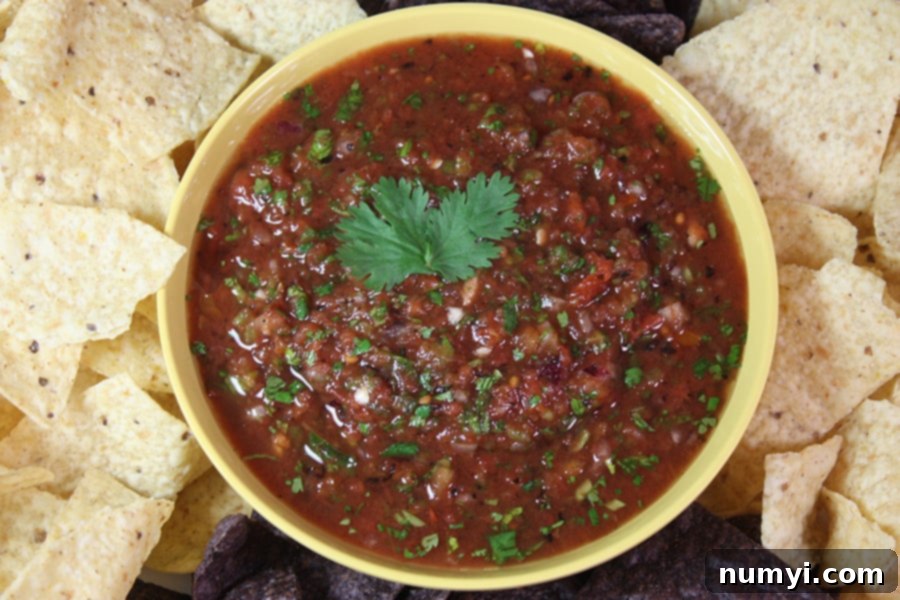
Expert Tips for the Best Fire Roasted Salsa
Achieving restaurant-quality fire roasted salsa at home is easy, especially with these helpful tips:
- Master the Pulse: Whether you’re using a food processor or a blender, the “pulse” function is your best friend. Instead of continuously blending, use short, quick bursts. This gives you precise control over the texture, allowing you to achieve a perfectly chunky or slightly smoother consistency without turning your salsa into an unappetizing mush.
- Control the Heat: The majority of the heat in a jalapeño comes from its seeds and the white membranes (veins) inside. For a milder salsa, always remove these completely. If you like it spicy, you can include some or all of the seeds. A great tip is to save some of the seeds on the side and add a tiny bit at a time after you’ve tasted the initial batch. This allows you to gradually increase the heat to your perfect level.
- The Power of Resting: Patience is a virtue, especially with salsa! While tempting to dive right in, letting the salsa rest in the refrigerator for at least one to two hours (or even overnight) is transformative. This chilling period allows all the individual flavors to marry and deepen, resulting in a more complex, well-rounded, and delicious final product.
- Taste and Adjust: Always taste your salsa before serving. Seasoning is subjective! You might want to add a bit more salt, a squeeze of extra lime juice for brightness, or even a pinch of sugar to balance the acidity if your tomatoes are particularly tart.
- Cilantro Love: If you’re a big fan of cilantro, don’t hesitate to add a little extra. For those who are not as fond of its taste, start with a smaller amount and add more gradually until it suits your preference.
Exciting Variations & Customizations
One of the best things about homemade salsa is how easily you can tailor it to your exact preferences. Don’t be afraid to experiment and make this fire roasted salsa truly your own!
- For Chunkier Salsa: If you prefer a more substantial, pico de gallo-like texture, simply process the ingredients less. Use fewer pulses and ensure some larger pieces of onion and tomato remain. Alternatively, you can finely dice some of the ingredients by hand and stir them in at the end.
- For Thinner Salsa: If you desire a smoother, more liquid salsa, process the ingredients for a longer duration, using more pulses until it reaches your preferred consistency. Add a tablespoon or two of water if it’s too thick after blending to thin it out slightly.
- Customize the Heat: You are the master of your spice! Increase or decrease the amount of jalapeño seeds and veins to control the heat. For a smoky, intense heat, consider adding 1-2 chipotle peppers in adobo sauce. For extreme spice, a touch of habanero or serrano peppers can be used (handle with care!).
- Enhanced Tomato Flavor: If you’re a true tomato aficionado, feel free to add an extra half can of fire-roasted tomatoes. This will result in a more tomato-forward salsa with a slightly increased yield.
- Cilantro Boost: Love that fresh, herbaceous note? Add an extra handful of fresh cilantro! If you’re not a fan, reduce the quantity or substitute with fresh parsley for a different fresh green flavor.
- More Garlic Goodness: For a more pungent and aromatic salsa, don’t hesitate to add an additional teaspoon or two of minced garlic.
- Spice It Up with Cumin: While our base recipe doesn’t traditionally include it, a pinch (1/4 to 1/2 teaspoon) of ground cumin can add an earthy, warm depth that complements the other Mexican flavors beautifully.
- Sweet & Savory Balance: A tiny pinch of sugar (1/4 teaspoon) can sometimes help balance the acidity of the tomatoes and lime, especially if your tomatoes are very tart.
- Add Other Veggies: For a heartier, chunkier salsa, consider adding other finely diced vegetables such as bell peppers (red, yellow, or orange for sweetness), corn kernels (fresh or thawed frozen), or even black beans (drained and rinsed) for an added textural and nutritional element.
Frequently Asked Questions About Fire Roasted Salsa
While both salsa and pico de gallo utilize similar core ingredients like tomatoes, cilantro, jalapeños, onions, and lime juice, their primary difference lies in consistency and preparation method. Salsa, particularly blended salsa like this fire-roasted version, is generally more liquid and has a smoother texture because the ingredients have been processed. Pico de gallo, also known as salsa fresca, is typically a chunky, uncooked mixture where all the ingredients are finely diced by hand, resulting in a fresh, vibrant, and chunky texture with very little liquid.
You can, but the resulting flavor will be noticeably different. Regular canned tomatoes will not provide the deep, smoky flavor profile that fire-roasted tomatoes impart, which is a key characteristic of this restaurant-style salsa. If you only have regular canned tomatoes, you could try charring a fresh tomato or two under a broiler before adding it, or adding a pinch of smoked paprika to mimic some of that smoky depth, but it won’t be exactly the same.
Salsa can become watery, particularly if you’re using fresh tomatoes with a high moisture content or if the canned tomatoes aren’t properly drained. To prevent this, ensure you thoroughly drain canned tomatoes before adding them to the processor. If using fresh tomatoes, opt for less watery varieties like Roma tomatoes, and consider gently squeezing out the “locules” (the gooey, seedy pulp) before blending. Over-blending can also release more liquid from the ingredients, so pulsing in short bursts is recommended.
Yes, typically for a milder salsa, it’s recommended to remove the seeds and the white membranes (veins) of the jalapeño pepper. These parts contain the majority of the capsaicin, which is responsible for the pepper’s heat. If you prefer a spicier version of your salsa, you can choose to include some or all of the seeds and veins, adjusting to your heat preference.
Absolutely! Homemade fire-roasted salsa freezes beautifully. To freeze, transfer the salsa into a freezer-safe airtight container or heavy-duty freezer bags, leaving a little headspace for expansion. It can be frozen for up to 3 months. When you’re ready to enjoy it, simply thaw it in the refrigerator overnight. The texture might be slightly softer after thawing, but the flavors will still be delicious.
To maintain its freshness and flavor, place your homemade fire-roasted salsa in an airtight container or a glass jar with a tight-fitting lid. Store it in the refrigerator, where it will stay fresh and delicious for about 1 week. Always use a clean spoon each time you serve to prevent contamination.
Other Delicious Mexican-Inspired Recipes to Try
If you loved this fire roasted salsa, you’ll surely enjoy these other fantastic Mexican-inspired dishes that are perfect for sharing!
Easy Black Bean Dip
Chuy’s Creamy Jalapeno Cilantro Dip
Restaurant Style Queso Dip
Are you on Pinterest? Click the button below to add this recipe to one of your boards!
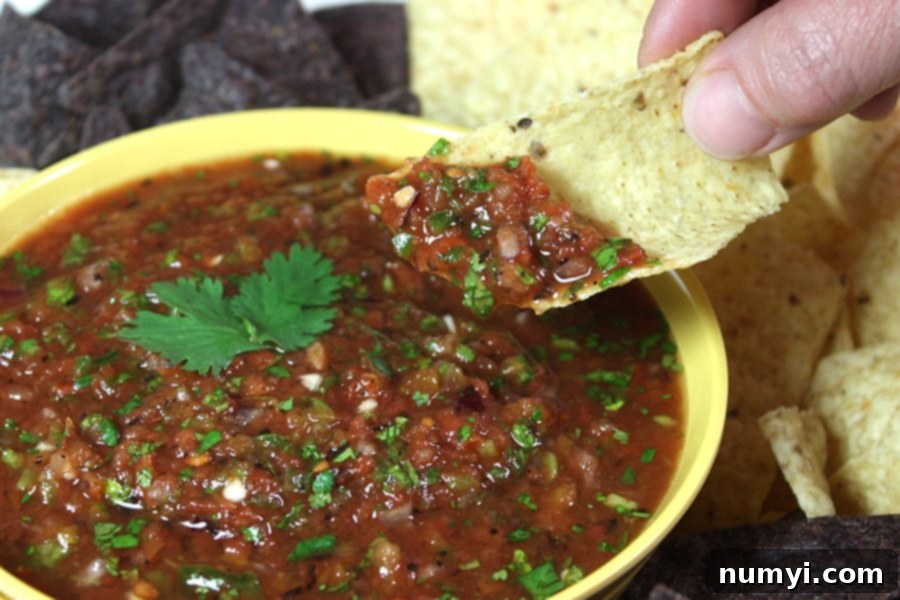
Fire Roasted Salsa Recipe
Print
Pin
Rate
Dip, Sauce
Mexican
5
5
12
25kcal
Don’t Sweat The Recipe
Ingredients
-
29 ounces fire roasted tomatoes, drained (2 – 14.5 oz cans)
-
4 ounces green chilies, diced (1 small can)
-
1 small red onion, diced
-
1 bunch cilantro (you can use less if desired)
-
1 lime (juice)
-
2 teaspoons garlic, minced
-
1-2 teaspoons salt (to taste)
-
1 teaspoon fresh ground black pepper
-
1 jalapeños, seeded and diced (1 or 2)
Instructions
-
Add all ingredients to a blender or food processor and pulse until you reach desired consistency.29 ounces fire roasted tomatoes, drained, 4 ounces green chilies, diced, 1 small red onion, diced, 1 bunch cilantro, 1 lime (juice), 2 teaspoons garlic, minced, 1-2 teaspoons salt (to taste), 1 teaspoon fresh ground black pepper, 1 jalapeños, seeded and diced
-
For best flavor place the salsa in a jar or container and chill for 1-2 hours or longer.
-
Store chilled in airtight container.
Notes
I LOVE cilantro so I add a ton. Decrease the amount if you aren’t as fond of cilantro as I am.
This recipe makes about 3 cups in volume.
Storing – Place the salsa in an airtight container or jar and refrigerate for about 1 week.
Freezing – Place it in a freezer-safe airtight container and freeze for up to 3 months. Thaw in the refrigerator.
Nutrition
Calories: 25kcal
|
Carbohydrates: 6g
|
Protein: 1g
|
Fat: 1g
|
Saturated Fat: 1g
|
Sodium: 332mg
|
Potassium: 23mg
|
Fiber: 1g
|
Sugar: 2g
|
Vitamin A: 332IU
|
Vitamin C: 6mg
|
Calcium: 25mg
|
Iron: 1mg
